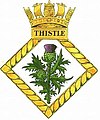
Summary
HMS Thistle (N24) was a T-class submarine of the Royal Navy. She was laid down by Vickers Armstrong, Barrow and launched in October 1938. She was sunk by the German submarine U-4 on 10 April 1940 near Skudenes, Norway.
 HMS Thistle
| |
| History | |
|---|---|
| Name | HMS Thistle |
| Builder | Vickers Armstrong, Barrow |
| Laid down | 7 December 1937 |
| Launched | 25 October 1938 |
| Commissioned | 4 July 1939 |
| Fate | Sunk by U-4 10 April 1940 |
| Badge |  |
| General characteristics | |
| Class and type | T-class submarine |
| Displacement |
|
| Length | 275 ft (84 m) |
| Beam | 26 ft 6 in (8.08 m) |
| Draught | 16.3 ft (5.0 m) |
| Propulsion |
|
| Speed |
|
| Range | 4,500 nmi (8,300 km; 5,200 mi) at 11 kn (20 km/h; 13 mph) surfaced |
| Test depth | 300 ft (91 m) max |
| Complement | 59 |
| Armament |
|
Career edit
At the onset of the Second World War, Thistle was a member of the 2nd Submarine Flotilla. From 26 to 29 August 1939, the flotilla deployed to its war bases at Dundee and Blyth.[1]
Thistle, under the command of Lt. Wilfrid Frederick Haselfoot, was ordered to patrol off Stavanger, and to sink any enemy vessel that she might spot in the harbour, since British authorities believed that a German invasion of Norway was imminent. On 10 April, Thistle signaled her intention to comply with this order and that she had two torpedoes remaining after an unsuccessful attack on a U-boat. With this in mind the Admiralty changed her orders to patrol off Skudenes. No further contact was made with Thistle.
Sinking edit
It was later discovered that U-4, the U-boat Thistle had previously attacked, had sighted the submarine on the surface and sunk her with torpedoes.[2]
The action began when HMS Thistle spotted U-4 cruising on the surface with a periscope. At 16:04 hours on 9 April 1940 HMS Thistle fired a spread of six torpedoes, all of which missed. HMS Thistle later reported the unsuccessful engagement via radio, and that the submarine had only two torpedoes left.
U-4 observed one torpedo passing ten meters ahead and evaded further underwater attacks by crash diving. The U-boat crew later heard three explosions of the off-track torpedoes at the end of their run. Afterwards U-4 found HMS Thistle on the surface recharging its batteries.
At 02:13 hours on the morning of 10 April 1940, U-4 fired a spread of two torpedoes at its attacker. The first, a G7a torpedo, missed. The second, a magnetic G7e torpedo, found its mark, sinking Thistle with all hands near Skudenes.
Discovery edit
The wreck of the Thistle, missing its tower,[3] was discovered by the Norwegian Institute of Marine Research in the spring of 2023, at 160 meters of depth.[4] A second cruise in October 2023 identified the wreck as being Thistle.[4] Royal Navy confirmed the boat is HMS Thistle. [5]
Notes edit
- ^ Rohwer, p. 1
- ^ Submarine losses 1904 to present day Archived 8 August 2007 at the Wayback Machine, RN Submarine Museum, Gosport
- ^ "British submarine from WWII found after 83 years". www.tv2.no. TV 2 Norway. 15 October 2023.
- ^ a b "Found unknown submarine wreck from World War 2". Norwegian Institute of Marine Research website. Norwegian Institute of Marine Research. Retrieved 16 October 2023.
- ^ "Wreck of British WWII submarine HMS Thistle found near Norway after 83 years".
References edit
- Akermann, Paul (2002). Encyclopaedia of British Submarines 1901–1955 (reprint of the 1989 ed.). Penzance, Cornwall: Periscope Publishing. ISBN 1-904381-05-7.
- Bagnasco, Erminio (1977). Submarines of World War Two. Annapolis, Maryland: Naval Institute Press. ISBN 0-87021-962-6.
- Chesneau, Roger, ed. (1980). Conway's All the World's Fighting Ships 1922–1946. Greenwich, UK: Conway Maritime Press. ISBN 0-85177-146-7.
- Colledge, J. J.; Warlow, Ben (2006) [1969]. Ships of the Royal Navy: The Complete Record of all Fighting Ships of the Royal Navy (Rev. ed.). London: Chatham Publishing. ISBN 978-1-86176-281-8.
- Kemp, Paul J. (1990). The T-class Submarine: The Classic British Design. Annapolis, Maryland: Naval Institute Press. ISBN 1-55750-826-7.
- McCartney, Innes (2006). British Submarines 1939–1945. New Vanguard. Vol. 129. Oxford, UK: Osprey. ISBN 1-84603-007-2.
- Rohwer, Jürgen (2005). Chronology of the War at Sea 1939–1945: The Naval History of World War Two (Revised & Expanded ed.). Annapolis, Maryland: Naval Institute Press. ISBN 1-59114-119-2.
59°00′N 05°00′E / 59.000°N 5.000°E


